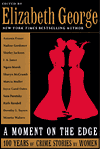|
From Pacific Northwest - The Seattle Time Magazine High Crime Art From California and now Seattle, Elizabeth George masters the British mystery
George and her husband are moving north, spending part of their time at a condo they bought on Capitol Hill while their new home is being built near Langley on Whidbey Island. We talked on her deck overlooking Puget Sound and the Space Needle. George is petite and soft-spoken but assured and assertive in her comments. Q: Why does a Southern Californian write British murder mysteries? A. Mostly because I always liked England. I even wrote short stories about England when I was in high school. I was attracted to the pop culture of the Beatles and British fashion during my formative teen years. Then I started reading English literature and really never thought about writing about anything else. Q. How much time do you spend in England? A. I go on location for a week, although if I'm writing about an institution like Cambridge University, that can take more like three weeks. Then I go back to England halfway through the course of writing the book and at the end for fine-tuning. For my last novel, "A Place of Hiding," I went to the island of Guernsey three times. Q. You've been so successful working between Huntington Beach and England. Why are you moving to Seattle and Whidbey Island? A. I've wanted to leave Southern California for a long time; I never really wanted to live there anyway. I was desperate to get back to seasons, and I love weather. My husband and I have been looking for a new place to live once he retired from firefighting. We looked all over, at Vashon, Lopez, Bainbridge, Sequim and Port Townsend, and then we visited a friend in Coupeville who said, "You will love Langley." It seems like Laguna Beach at the turn of the century. Most people don't realize how beautiful it is up here. Q. Why an anthology of women crime writers? A. It was a chance to search out stories that support my belief that crime stories are part of the general body of literature, not a lesser form of literary endeavor. Many fine novels have at their heart a crime, such as "To Kill a Mockingbird" or Hardy's "Desperate Remedies." Novels need drama and conflict, and nothing is more dramatic than a crime to disrupt the status quo. Q. How long does it take you to write a murder mystery? A. I usually spend about 2½ years on a book, partly because I have to go to England for research during the writing and revision. I have a book coming out next March that I wrote 800 pages on before I realized it was too complicated and removed part, which will be the next novel already in draft form. Q. Will this new book coming out in March be a Detective Inspector Lynley mystery? A. All five major continuing characters will be in it, with an emphasis on Lynley, Barbara Havers and Winston Nakata. It's called "With No One as Witness" and is about a hunt for a serial killer in London. I've always intended to have a cast of series characters, with some coming to the forefront and others receding, because it makes it all more interesting for me. Q. How do you teach someone to write, which is the subject of your other new book, "Write Away: One Novelist's Approach To Fiction and the Writing Life"? A. Well, I was a high-school and community-college English teacher for
many years. While writing is an art, it is dependent upon mastering craft.
I firmly believe it can be taught. While you can't teach someone to be an
artist, you can teach them to be a craftsman.
Elizabeth George's new book, due out this month, is "A Moment on the Edge: 100 Years of Crime Stories by Women," edited by Elizabeth George (Harper Collins, first U.S. edition, 2004, $24.95). This collection of 26 stories suggests that most women authors of note in the past century have turned their hand to writing at least one story that is creepy, weird, violent, ugly or tricky, centering on a mystery or crime. You'll find the usual murder, mayhem and hard-boiled women cops, but George does a fine job of expanding the genre far beyond what we might expect. "Crime writing is practically as old as writing itself and is consequently very much part of our literary tradition," writes George in the introduction, pointing out crime stories from the Bible to present-day newspaper accounts of serial murders. She notes that in the United States the present Golden Age of Mystery is dominated by men, while in England, where this collection was first published, women such as Agatha Christie and Margery Allingham have long reigned as queens of mystery. Authors range from masters of the genre like Sara Paretsky and Dorothy Sayers to surprises such as Joyce Carol Oates, with a tale of matricide, and Nadine Gordimer, who tells a sad story of illicit love. George lends context to each story by introducing its author with a short summary of her work and place in literature. Most impressive is that while many of the women writers build on previous traditions in intriguing ways, such as Barbara Paul's story told from the point of view of Jack the Ripper's wife, many of the tales are original, startling and compelling. If nothing else, George introduces us to a wealth of women writers and future fictional pleasures. Valerie Easton is a Seattle freelance writer and contributing editor for Horticulture magazine. Her e-mail address is valeaston@comcast.net. Copyright (c) 2004 The Seattle Times Company |

